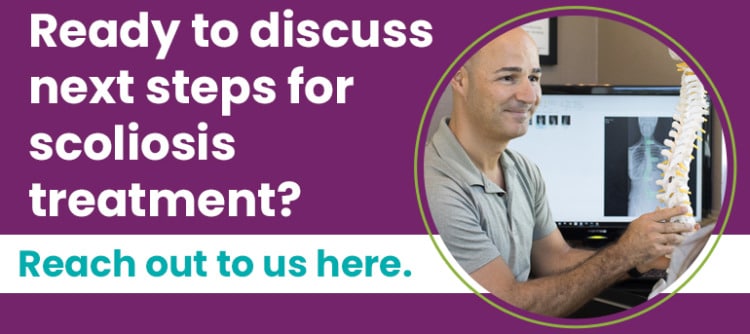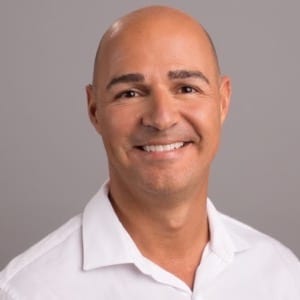Scoliosis Meaning: Understanding Spinal Curvature
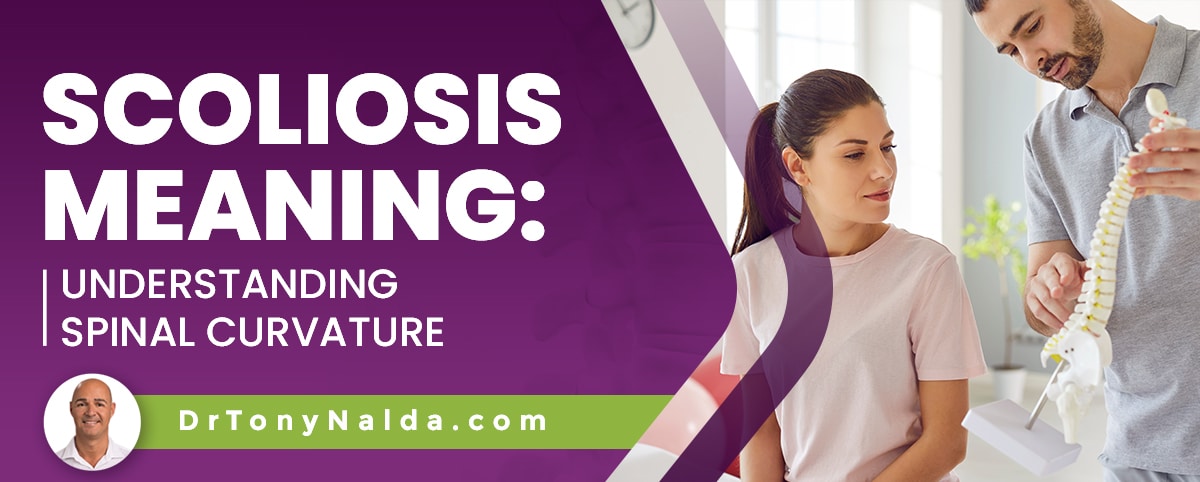
Scoliosis causes an unhealthy spinal curve to develop, and the spine's natural and healthy curves make it stronger, more flexible, and better able to handle mechanical stress from movement and impact. Understanding the role of the spine's healthy curves is important for understanding what happens when they're lost.
Many people are diagnosed with scoliosis, but what does a diagnosis mean? A scoliosis diagnosis means an unnatural spinal curvature that bends to the side and twists has developed, and this means the spine has lost one or more of its healthy curves.
The spine is curved at each of its main sections, so let's start with the spine's healthy curve types.
Table of Contents
Healthy Spinal Curvatures
The spine performs many key roles in human anatomy; it helps us stand upright, practice good posture, protects important organs, facilitates movement, and works with the brain to form the body's central nervous system.
The spine has three main sections: the cervical spine (neck), the thoracic spine (middle/upper back), and the lumbar spine (lower back).
The spine consists of vertebrae stacked on top of one another in a straight and neutral alignment, and adjacent vertebral bodies are separated by an intervertebral disc.
The spinal discs make the spine stronger, give it structure, act as the spine's shock absorbers, provide cushioning between vertebrae, and combine forces to facilitate flexibility and range of motion.
As one long structure, the health of each spinal section is dependent on the health of the others, and if an unhealthy spinal curvature develops in one section, it's not uncommon for another section to develop a compensatory curve in an attempt to counteract the first unnatural curve's uneven forces.
Lordosis and Kyphosis
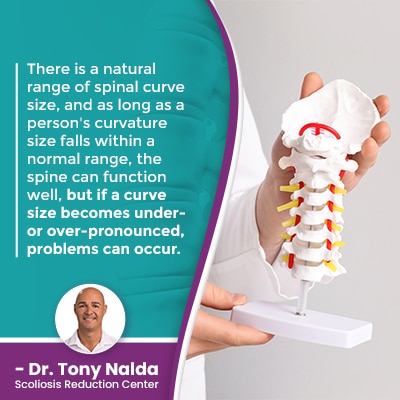 The cervical spine and lumbar spine feature a curve type known as lordosis: curves that bend inwards, towards the center of the body, and the thoracic spine has what's known as kyphosis, a curve that bends outwards, away from the center of the body.
The cervical spine and lumbar spine feature a curve type known as lordosis: curves that bend inwards, towards the center of the body, and the thoracic spine has what's known as kyphosis, a curve that bends outwards, away from the center of the body.
There is a natural range of spinal curve size, and as long as a person's curvature size falls within a normal range, the spine can function well, but if a curve size becomes under- or over-pronounced, problems can occur.
The spine's healthy curves are key to its health and function, and a healthy range of cervical lordosis would fall between 20 and 40 degrees, and a healthy range of lumbar lordosis is considered between 40 and 60 degrees; a normal range of thoracic kyphosis is between 20 and 40 degrees.
All of the spine's structures and sections work together to maintain spinal health and motion, but what happens if one or more of the spine's healthy curves are lost and replaced by an unhealthy curve?
Unhealthy Spinal Curves
When the spine loses a healthy curve, it's replaced by an unhealthy curve, and a single unnatural curve can disrupt the biomechanics of the entire spine.
It's also possible for the loss of a single healthy curve to cause the development of a compensatory curve in an attempt to counteract the uneven forces of the first unhealthy spinal curvature.
An unhealthy spinal curve will make the spine weaker, more vulnerable to injury, less flexible, and disrupt the spine's ability to handle stress.
An unhealthy spine is one that can disrupt posture and cause varying levels of pain; it can also be excessively rigid with a reduced range of motion and spinal flexibility.
There are a number of spinal conditions that can cause a loss of its healthy curves, but scoliosis has some unique characteristics.
What is Scoliosis?
Scoliosis is a structural spinal condition that causes the spine to bend unnaturally to the side, but it also makes the spine rotate, and the rotational component is necessary to be considered a true scoliosis.
Scoliosis is also a progressive condition, meaning the unnatural spinal curvature will become larger over time, the condition's effects will become more noticeable, and the condition will become more complex to treat.
Scoliosis can affect all ages, but is most commonly diagnosed in children, and adolescent idiopathic scoliosis is the most prevalent type overall.
The size of an unhealthy scoliotic curve can range widely from mild very severe scoliosis, and the size and severity of a scoliotic curve is determined by a measurement known as Cobb angle determined during X-ray.
A patient's Cobb angle is determined by drawing lines from the tops and bottoms of the curve's most-tilted vertebrae, and the lines form an angle that's expressed in degrees, and the higher the Cobb angle, the more severe the condition:
Mild scoliosis is diagnosed with Cobb angle measurements of between 10 and 25 degrees
Moderate scoliosis involves Cobb angles of between 25 and 40 degrees
Severe scoliosis is diagnosed at 40+ degrees, and very severe scoliosis cases feature 80+ curves
The higher a Cobb angle, the more misaligned the spine is, and the more uneven forces there are being exposed to the spine, its surroundings, and the entire body.
How is Scoliosis Addressed?
The goal of scoliosis treatment is to restore as much of the spine's natural curves as possible.
When it comes to restoring healthy spinal curves, determining the underlying cause is key, but with scoliosis, in the majority of cases, we don't know what causes it to develop; approximately 80 percent of known cases are idiopathic scoliosis, and the remaining 20 percent have known causes.
Neuromuscular scoliosis, degenerative scoliosis, and congenital scoliosis are considered atypical because they have known causes, unique characteristics, and treatment needs.
In typical cases of idiopathic scoliosis, the scoliosis curves bend to the right, away from the heart, but in an atypical type of scoliosis, the curve can bend to the left, towards the heart.
Atypical Types of Scoliosis
In cases of neuromuscular scoliosis, the scoliosis develops because of a larger condition like spina bifida, muscular dystrophy, or cerebral palsy causing a disconnect between the brain and the muscles and/or connective tissues that support and stabilize the spine; the larger neuromuscular condition has to be treated.
In cases of degenerative scoliosis, natural age-related spinal degeneration is the cause so the treatment focus is on preserving existing spinal function and increasing the spine's support and stability.
Cases of congenital scoliosis are caused by spinal malformations that occur in utero, so the spinal malformations can sometimes require surgery; these patients have to be comprehensively assessed because they often present with additional congenital abnormalities.
The goal of scoliosis treatment is to restore as much of the spine's healthy curves as possible, and when it comes to conservative treatment options, this combines scoliosis-specific chiropractic care, physical therapy, corrective bracing, and rehabilitation.
Muscles and Spinal Curvatures
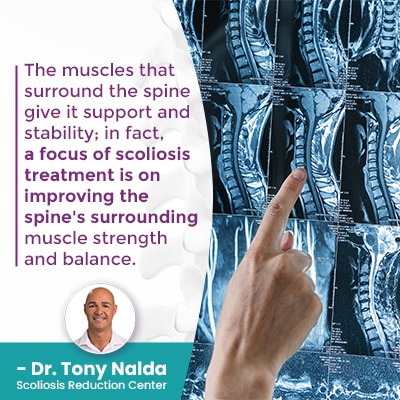 What's interesting about the spine is although it's such a strong and complex structure, it needs help to maintain its natural curves and alignment, and this is where the spine's surrounding muscles come in.
What's interesting about the spine is although it's such a strong and complex structure, it needs help to maintain its natural curves and alignment, and this is where the spine's surrounding muscles come in.
The muscles that surround the spine give it support and stability; in fact, a focus of scoliosis treatment is on improving the spine's surrounding muscle strength and balance.
Scoliosis can also disrupt the symmetry of the spine's surrounding muscles by causing a muscular imbalance as the unnaturally curved spine pulls them in different directions, making the muscles on one side of the spine tight and sore from overuse and muscles on the other side weak from underuse.
So when it comes to understanding spinal curvatures, it's important to understand the role of muscular support.
Conclusion
Here at the Scoliosis Reduction Center®, I specialize in non surgical treatment options: chiropractic care that works towards manually adjusting the spine's alignment, physical therapy that strengthens and balances the spine's surrounding muscles, corrective bracing that pushes the spine into a alignment, and rehabilitation to further heal and stabilize the spine.
The signs of scoliosis can be subtle, but scoliosis diagnosed early and treated early in its progressive line can be highly treatable.
I diagnose scoliosis through a combined physical examination, during which I ask the patient to bend forward; spine abnormalities and trunk asymmetries are highly visible in this position.
X-ray results are also needed to confirm the rotational component and a patient's Cobb angle measurement.
While scoliosis can also be treated with spinal fusion surgery, the procedure is invasive and risky and can cost the spine in terms of its natural strength, flexibility, and function; the risks of spinal fusion are real so should be considered carefully.
In addition, many cases of scoliosis don't require surgical procedures, particularly with early diagnosis and intervention.
When scoliosis treatment is started immediately following a diagnosis, the condition will be at its mildest and most responsive, and an unnatural curve of the spine can always benefit from treatment.
Dr. Tony Nalda
DOCTOR OF CHIROPRACTIC
After receiving an undergraduate degree in psychology and his Doctorate of Chiropractic from Life University, Dr. Nalda settled in Celebration, Florida and proceeded to build one of Central Florida’s most successful chiropractic clinics.
His experience with patients suffering from scoliosis, and the confusion and frustration they faced, led him to seek a specialty in scoliosis care. In 2006 he completed his Intensive Care Certification from CLEAR Institute, a leading scoliosis educational and certification center.
About Dr. Tony Nalda
 Ready to explore scoliosis treatment? Contact Us Now
Ready to explore scoliosis treatment? Contact Us Now